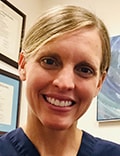No End in Sight for Canadian ED Crisis

Emergency departments (EDs) in Canada face a summer with “dire consequences” for the healthcare system, despite measures put in place by federal and provincial governments to deal with the crisis, writes Catherine Varner, MD, deputy editor of the Canadian Medical Association Journal, in an editorial published online June 19.
Dr Catherine Varner
“While the media and lay attention is often focused on factors outside of the hospital that impact crowding in EDs, the main driver of the unprecedented crowding in Canadian EDs is hospital overcrowding,” Varner, who is also an emergency physician in Toronto and associate professor at the University of Toronto, told Medscape Medical News.
“Canada, simply put, does not have enough acute care hospital beds to care for people needing to be hospitalized, and this results in patients spending many additional hours, if not days, in the ED waiting for a bed in the hospital,” she said.
“This backlog of care results in patients being seen in the waiting room, and we are now in a perpetual state of providing ‘waiting room medicine,’ ” she added.
In effect, “Canadian ED providers are caring for patients in spaces that are not safe or appropriate for patient care, including in waiting room chairs and hospital driveways.”
No Silver Bullet
In her editorial, Varner points to several factors that underlie the current ED crisis in Canada. Despite a return to baseline volumes in 2022 after a dramatic decrease in April 2020, the capacity of EDs to provide care “has been outstripped,” she writes. Owing to hospital staffing shortages and bed closures, patients who are admitted to the hospital are subjected to much longer stays in the ED. The inability to move those patients from emergency beds has resulted in crowding and prevents the delivery of timely, effective care.
Trends in ED usage also have changed, she writes. Before the pandemic, peaks in ED use tended to occur predictably during flu season and in the summer months, when patients’ usual providers were away. “The peaks were brief, sharp, and buffered by long troughs,” whereas now, EDs operate at peak occupancy for weeks at a time.
This development means that hospitals have little time to clear backlogs. Nor is there enough time for ED providers to recover from the “moral injury that occurs when they must treat sick patients in waiting rooms and feel unable to provide high-quality care in overwhelmed EDs.”
Furthermore, the summer months also bring a higher risk for climate-related disasters, such as the heat dome of 2021 and wildfires. This risk contributes to human resource crises in EDs that often force closures.
In her editorial, Varner highlights two programs that were put in place to help mitigate ED overcrowding and understaffing. In April 2020, British Columbia launched Real-Time Virtual Supports, which includes four programs that provide on-demand clinical support for emergency providers working in rural, remote, and Indigenous communities throughout the province.
The second initiative is Ontario’s Emergency Department Peer-to-Peer program, which supports 56 rural and remote EDs and gives physicians access to immediate, on-demand peer coaching for all levels of patient acuity.
Nonetheless, Varner writes, “These attempts, while laudable, fall short of the necessary,
systemwide response to the current crisis, which has been decades in the making and was predicted by emergency personnel and accelerated by the pandemic…. [T]he
demand for emergency care exceeds the capacity of emergency medicine health human resources in all regions of Canada now and for the foreseeable future.”
Of note, the Canadian Association of Emergency Physicians recently posted a draft report, the Future of Emergency Care in Canada, which makes “specific and informed recommendations for healthcare leaders at all levels,” Varner told Medscape. “While I was not part of this task force, I agree with the authors’ statement that ‘there is no silver bullet or easy solution to fix emergency care.’
“Through the course of the pandemic, EDs in Canada have been at the epicenter of all challenges facing our health care system,” she said. “The distress emergency providers feel treating patients in the waiting room day after day is untenable. Many of our most experienced emergency medicine nurses and doctors in Canada have left or are leaving.
“My vision for the future is that governments and healthcare system leaders at all levels respond in a way that is commensurate with the crisis — that it is not simply hope for the best.”
Deterioration Expected
“We are the barometer of the state of the healthcare system, yet no one seems to worry when the situation worsens in EDs across the country,” Judy Morris, MD, a family and urgent medicine specialist at Sacré-Cœur Hospital in Montreal and president of the Quebec Emergency Physicians Association, told Medscape.
Dr Judy Morris
“As Mike Howlett, president of the Canadian Association of Emergency Physicians, said last week at the International Conference on Emergency Medicine 2023, ‘The ER right now is an afterthought,’ ” she said. She also pointed to a letter Howlett wrote to ministers of health and premiers in which he explained that “Canadian emergency care is being crushed, and why that matters to everyone.”
Morris previously commented for Medscape on overcrowding in Quebec’s EDs, noting that despite the development of a set of recommendations from a crisis team, “What we see is a lot of things written on paper, but not a lot of things applied.”
Similarly, throughout Canada, she said, the crisis relates to implementation. “Much has been written on the solutions to the crisis, but on the ground, very little is being done.
“Although interesting, the programs described by Varner are indeed not enough,” she said. “Systemwide changes need to occur. The shortage of healthcare workers countrywide, if not worldwide, is contributing to the challenge.”
Until the challenges are met, she said, “unfortunately, deterioration of the quality of free and accessible health care for Canadians is to be expected.”
CMAJ. Published online June 19, 2023. Full text
Follow Marilynn Larkin on Twitter: @MarilynnL.
For more news, follow Medscape on Facebook, Twitter, Instagram, and YouTube.
Source: Read Full Article

